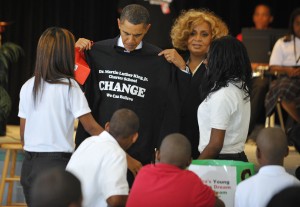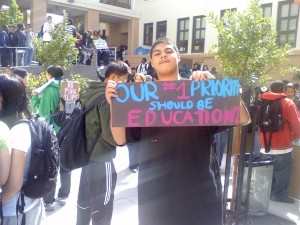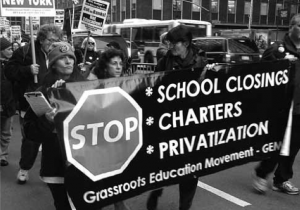Charter Schools
Charter Schools were first promoted by Ray Budde, an education professor, in 1988.
Later that year, the cause was taken up by Albert Shanker, president of the American Federation of Teachers. Charters were to be “new public schools,” proposed and run by teachers. But it didn’t take long for the idea of teacher-run schools to give way to corporate-run schools.
Today, charter schools are independent schools with privately run administrations (for- and non-profit) and largely non-unionized teachers. Their funding comes both from tax dollars and private, often corporate, donations. Though they take public dollars, because they are privately run, the U.S. Census Bureau classifies them as private schools. They thrive in ghetto neighborhoods, largely serving segregated black and Latino students.
The promise of charters is that they are “innovative,” “flexible,” and “nimble” and can give children a better education than traditional public schools. Whether they actually are better is a critical question. A 2013 Stanford University study found 25 percent of charters had significantly stronger growth than traditional public schools in reading scores, though 19 percent of charters performed worse, and the rest performed about the same. In math, 29 percent of charters performed better, while 31 percent performed worse. Overall, charters performed better than they did in a 2009 report by the same researchers, in large part because 8 percent of the charters in the original study had since closed. But at this point, they are not, overall, better than traditional public schools.
The five articles here examine charter schools from very different angles. Christopher Bonastia traces the “hidden history” of charters in two responses to school desegregation—segregationists creating whites-only schools to avoid integration and the short-lived community control movement that sought to give black and Latino parents more say over their de facto segregated schools. Linda Renzulli and Maria Paino point out the rhetoric of innovation means that if charters do not succeed academically they should close. In their research in North Carolina, they show charters that close do so largely for fiscal and administrative reasons, but none has closed for poor educational outcomes. And in a third critical piece, Diane Ravitch argues that charters threaten the American public school system by taking public dollars while remaining privately controlled. Ultimately, because charters turn schooling into a market activity rather than a public good, they are, Ravitch reasons, a threat to democracy itself.
Two of the writers here have more positive outlooks. Carl Bankston III argues charters have been good for the mostly poor students of New Orleans, where charters are outperforming the traditional public schools they replaced post-Katrina. Michael Petrilli goes further, writing that charters could actually be the way forward for the whole country, helping solve the school segregation problem as gentrification increases across cities.
Petrilli’s point that desegregation is desirable is important. But why? A recent New York Times article, to name just one example, shows how poor kids in Greenwich, CT, who go to school with mostly rich kids do much better academically than those who go to school with mostly other poor kids. This echoes results of a short-lived, class-based busing program in Wake County, NC, which seemed to help raise test scores for poorer black and Latino students. Of course, one conclusion from studies like these is, if you want children to learn and do well in school, it may not be the type of school they go to that’s important, but the type of kids in their classes and schools. If that’s the case, it adds yet another wrinkle in the charter school debate.
— Syed Ali
- What New Orleans Can Teach Us, by Carl L. Bankston III
- Profits and Principles, by Diane Ravitch
- Charters Can Desegregate Our Schools, by Michale J. Petrilli
- Accounting for Academics, by Linda A. Renzulli and Maria Paino
- Charter Schools’ Segregationist Roots, by Christopher Bonastia
What New Orleans Can Teach Us
by Carl L. Bankston III

The rise of charters in New Orleans has brought its own problems. Under the new system, per student costs have risen, especially transportation costs. Parents have complained of difficulty in getting information about the different schools and that application procedures are too complicated. The multiple-provider system means school quality is uneven. Eleven charters
have closed since 2006 due to insufficient academic progress. The wide gaps between students in the few selective public schools (most charters are not selective) and the schools at the bottom remain.

Student performance scores have improved steadily since charter schools became dominant. On ACT tests and on the SPS, schools in New Orleans have shown greater improvement than those in the rest of the state. The six schools located in New Orleans that made the state’s list of High Performing-High Poverty Schools were all charters. In focus groups conducted in 2012 by Tulane University’s Cowen Institute (the best source of information on the district) parents expressed strong support for the choices made possible by charters, qualified primarily by concerns over the complicated application process.
It would be difficult to attribute the improvement to post-hurricane demographics. In 2004, the district’s schools were 93 percent African American and 77 percent of students were eligible for free and reduced-price lunch. By the 2011-2012 school year, close to 90 percent were African American, with 85 percent eligible for free and reduced-price lunch. While it’s possible there are subtle demographic differences not picked up by these rough statistics, the fact that school test scores improved overall and in each year after the storm strongly suggests that the cause was the change in schools.
Determining what about these schools moved test scores upward is difficult, though. Many charter school operators would argue it’s due to their innovative curricular programs. Others would argue competition for students forces schools to improve. Another possibility is that the charter system enables motivated students, or students with motivated parents, to use the city-wide open enrollment system of most charters to move from schools with low-achieving classmates to schools that tend to concentrate the more highly motivated, thus creating better learning environments. Any combination of these explanations supports the view that choice in New Orleans has provided overall benefits, however unequally distributed.
We can draw several tentative insights about charter schools from the New Orleans case. First, a shift to charters can be an effective strategy for improving education, but whether it’s the right strategy depends on context and alternatives. Generally, students in New Orleans have benefitted from this reform, but districts with high-functioning traditional public schools should be cautious of any radical overhaul. Second, the charter school approach is not a panacea—those undertaking this approach should do so without unrealistic expectations of ending educa- tional disadvantages or eliminating achievement gaps. Third, districts opening charter schools should have clear plans for dealing with the major challenges posed by this strategy. These plans must include close oversight and judgment of the quality of charter designs before schools are allowed to open, ways of distributing dependable and comprehensible information about school offerings and ratings to families of potential students, ongoing practical research to identify programs that serve the needs of specific categories of students, and an affordable transportation system that will make choice a reality.
Profits and Principles
by Diane Ravitch

Initially, the charter laws in most states limited the number that might be created. However, when the Obama administration created its Race to the Top program in 2009, dangling nearly five billion dollars for education funding in front of eager states, one of the conditions was an increase in the number of charter schools.
Championing these pro-charter policies has come at the expense of traditional public schools. Charters have widespread support from public officials at all levels, including President Obama. But just as importantly, charters have received support and funding from a host of political groups, business leaders, and hedge fund managers.
Typically, the supporters of charter schools argue that by providing “choice,” they help poor and minority students “escape from failing schools.” But many studies have determined that charter schools’ performance varies widely; most are no better, and many are worse, than traditional public schools.
While the effect of charters on education outcomes is mixed, they have been very successful at gaining profits and control for themselves. Charters introduced the novel concept that schools receiving public funds and calling themselves “public” schools could operate as for-profit enterprises. In Michigan, for example, 80 percent or more of charter schools operate for profit. This phenomenon has produced a new breed of entrepreneurs who look on schooling as a way to make money. For example, former New York City councilwoman Eva Moskowitz is now the CEO of the chain of Success Academy charters, drawing an annual salary of around $400,000—far more than the New York City schools’ chancellor.
Some entrepreneurs have also successfully established “virtual” or online charter schools. The largest of the virtual charter corporations is listed on the New York Stock Exchange. These schools have become immensely profitable, even though their academic results are poor. They also have become a way in which home schooling families can receive state tuition money, since, in the past, these parents had taught their children at home without public subsidy.
While profit is a primary motive for some charters, managerial control is a close second. Approximately 90 percent of charters are non-union. Their teachers serve at will and may be dismissed easily. This lets charters save money, but also tends to result in high teacher turnover. An organization like Teach for America provides large numbers of teachers to the charters’ ranks. These recruits are recent college graduates with five weeks of teacher training. Their inexperience makes them cheap labor, and most will leave for graduate school or a new career within a couple of years.
Charter schools present a direct challenge to American public education. While they like to use the word “public,” they have argued in federal court and in proceedings before the National Labor Relations Board that they are private organizations, outside the reach of state labor laws. If they are, as they maintain, private organizations with a contract to run a school, they are not public schools.
Nationally, the charter sector claims only four percent of enrollment. But in many cities, charter enrollment is approaching half the student population. In Detroit, Philadelphia, Indianapolis, and many other impoverished districts, the survival of public education is very much in question. New Orleans, after Hurricane Katrina, has more than 80 percent of its students in charter schools; two-thirds of those charters are academically unacceptable, according to the Cowen Institute at Tulane University, which nonetheless supports the charter movement.
As the charter movement evolves, it creates legitimacy for the idea that schooling should be a free-market choice, rather than a public responsibility. This ultimately undermines public education, which has been an integral part of American democracy for at least 150 years. It has been the institution that the courts have turned to on behalf of civil rights issues, whether desegregation, gender equity, or the rights of students with disabilities. The public schools, whatever their faults, have a legal duty to admit all students and to adhere to the principle of equality of educational opportunity. Turning schooling over to the market economy holds high risks, not just for the survival of public education, but for democracy itself.
Charters Can Desegregate Our Schools
by Michael J. Petrilli

But could charter schools actually be a solution to segregation—particularly as gentrification brings more white and middle-class families to our urban cores? A growing crop of social entrepreneurs thinks so. In cities across the country, educators and parents are starting charters expressly designed for diversity.
Charter schools have certain advantages. As start-up schools, they can be strategic about locations, picking spots that are well positioned to draw students from different racial and socioeconomic groups. They can design academic programs that take diversity as a given and make the most of it. And they can be thoughtful about putting elements in place to appeal to whites and blacks, Asians and Hispanics, rich and poor.
Capital City Public Charter School in Washington, D.C., was founded in 2000. It’s one of the oldest charter schools with significant racial and socioeconomic diversity. It serves elementary and middle school students from almost every zip code in the city, which helps it achieve a nearly even racial and socioeconomic balance. Thirty-six percent of its students are black, 32 percent white, 28 percent Hispanic, and 4 percent Asian. Forty percent of students are eligible for free or reduced price lunch. Perhaps its demographics help to explain why Cap City was the very first school Barack and Michelle Obama visited after the president’s first inauguration.
Capital City is also a proudly progressive school; it uses an Outward Bound expeditionary learning approach that engages students in fieldwork, community service, and interactions with experts. This is a big attraction for many parents, especially the more affluent ones. (Research has shown that upper-middle-class parents, especially whites, are more likely to want a “progressive” education for their children, though this type of teaching is generally less popular among blacks and low-income parents.)
Another reason the school has successfully attracted affluent white families and maintained a racial balance is that it was founded by white parents. At the time, the founders’ children attended Hearst Elementary, a public school in a ritzy Northwest D.C. neighborhood. Parents upset when a new superintendent imposed an unfriendly principal on their school and transferred some of their best teachers elsewhere recruited one of their teachers, Karen Dresden, to run the charter school. Dresden is still running Cap City today, and she credits the parents for having the vision to create a diverse school. “What I was really impressed with was they were committed from the very beginning to creating a school not just for their own kids to attend, but for all children,” Dresden told me.
The school’s original location was critically important, too. Like many charters, Cap City had to scramble to find available space; it settled on a commercial facility in the heart of the city. Ten years ago, Dresden said, “This was really a rocky area. It was all vacant lots; it wasn’t developed like it is now. When we decided to locate the school here there were a few members of the founding group who decided, for various reasons, that they did not want their kid to come here. I think they were feeling a little too unsafe. But that was actually a really good thing. The people who were really committed to it said, ‘This is where we’re going to have the most diversity.’”
Now Cap City has such a strong reputation that it doesn’t have to worry about recruiting enough white and middle-class students. There is a mile-long waiting list of children from affluent neighborhoods like Capitol Hill and Chevy Chase. “There are families choosing Capital City today that would have never chosen it when we started,” Dresden shares. The school’s bigger problem is making sure that enough low-income and minority students enter its lottery. (Local policies don’t allow charter schools to hold separate lotteries by race or class.) To that end, the school does an enormous amount of outreach in Latino and African American communities. So far, it has maintained its diversity, but as the District of Columbia continues to gentrify, this will be a continuing struggle.
Nevertheless, schools like Cap City demonstrate that charter schools, with their regulatory freedom and entrepreneurial zeal, can be spunky solutions to seemingly intractable problems— including, it turns out, America’s segregated schools.
Accounting for Academics
by Linda A. Renzulli and Maria Paino

The rhetoric behind charters assumes if the schools do not improve academic test scores and learning for students, they’ll be shuttered. But a recent report from the Center for Education Reform notes that, nationally, less than one-fifth of closures occurred because of academic failures. In fact, most are due to financial problems and administrative mismanagement. These schools have reported “low funding levels, low enrollment, and high transportation costs” or “small program with operating costs higher than were sustainable” when supplying justification for their closures.
A recent study from a new unique dataset has begun to shed light on the accountability issues within charter schools. The new data combines information on each location (for example, its mission statement, enrollment, and academic scores) and information on the physical district in which the charter school is located (including academic scores, demographics, and financial/expenditure reports). The first analyses have come out of the state of North Carolina, and the data reveal interesting and surprising results. They show us how—and to whom—charter schools are held accountable.
In North Carolina, none of the charter schools that have shut down said it was due to academic failure, though that’s far from the national trend of 20 percent closing for academic reasons. Indeed, some charters with good academic scores closed for lack of funds or because administrators had so much freedom they took advantage of loose bureaucratic structures to enter into shady business deals. Most schools that supplied financial explanations as the reason for closure, however, also had academic scores far below the district and overall charter school average. Schools can report multiple reasons for closure, but, despite consistently low scores, none of the schools in North Carolina included academics in their self-assessments.
One charter, LIFT Academy in Winston-Salem, failed to keep accurate financial records, never paid payroll taxes, and operated at a deficit. Our data reveal a number of school closures under similar conditions. PHASE Academy in Jacksonville closed for financial reasons too, but here the principal also stole money, hired a dishonest auditor, and paid only some of the school’s teachers. In the end, the state of North Carolina held these schools fiscally accountable, but the system allowed for corruption and fiscal crisis to occur in the first place.
It is important for understanding charter school accountability that financial circumstances trumped all other problems and possibilities offered up by the closed schools themselves. The state of North Carolina ordered LIFT and PHASE to close because of money. What remained largely overlooked and unmentioned was that LIFT’s racial demographics didn’t reflect the district (failing to meet the standards of the laws), and its students had very low academic scores. In contrast, PHASE had academic scores on par with other charters in the state; it was educating its students well, but its system allowed for corruption and fiscal difficulty. In neither case was it academics that closed or helped keep a school open.
Given our overall findings in North Carolina, we see little reason to expect major differences on a national level. In those cases in which charter schools close due to poor academic scores, they are keeping their promise of academic accountability to students and parents. But when charters close for financial or administrative mismanagement, despite good academic scores, they are really only being held accountable to politicians and taxpayers. Furthermore, data on academic achievement is poorly
documented and hard to obtain, so it’s tough for researchers (let alone parents and politicians) to determine how well charters are actually performing and whether they are being held accountable to their constituents by that measure.
Charter Schools’ Segregationist Roots
by Christopher Bonastia

The hidden history of the segregated charter school present lies with two responses to school desegregation, both of which sought to weaken centralized bureaucratic control of public education. The first came from white, Southern segregationists fighting to maintain whites-only schools by publicly subsidizing private schools. The second came from the black and Latino community-control movement of the late 1960s and ‘70s, in which families who had found themselves in de facto segregated schools in spite of legal prohibitions against segregation spoke up.
On the face of it, segregationist whites and charter school supporters share little in common. But both leveraged the quasi-public status that made public funding available to them while insulating them from rules governing traditional public education, such as desegregation requirements (segregated academies) or teacher tenure protections (charter schools).
To avoid desegregation, Southern states and localities used tuition grants to subsidize enrollment in private, non-sectarian schools for whites. As I’ve explored in my own writing, the most egregious move came in Prince Edward County, VA, which abandoned public education for five years (1959-64). As the county awaited a final desegregation order, its leading segregationists plotted to maintain public financing of all-white schools. In January 1957, local newspaper publisher J. Barrye Wall informed the county’s congressional representative that “we are working [on] a scheme in which we will abandon public schools, sell the buildings to our corporation, reopen as privately operated schools with tuition grants from Va and P.E. county as the basic financial program… Those wishing to go to integrated schools can take their tuition grants and operate their own schools. To hell with’ em.” Contemporary charter operators surely would use more polished, less explicitly racial language. But the core philosophy—that empowering parents to choose from a menu of distinct school “products” is the cornerstone of educational reform—remains the same. When Prince Edward closed its public schools in September 1959 to avoid desegregation, few white students missed even a day. Instead, they enrolled in the newly created, whites-only Prince Edward Academy. Black students had no educational options in the county.
By the late 1960s, many locales in the U.S. were still dragging their feet on desegregation. In New York, many asserted that officials showed no interest or political will to desegregate schools. Frustrated, black and Latino parents in Harlem, Ocean Hill-Brownsville (Brooklyn), and other neighborhoods demanded greater control over personnel decisions and daily operations of their local schools. The shift from demands for integration to community control of segregated neighborhood schools accelerated at the end of the 1960s. Responding to opposition from the United Federation of Teachers and Board of Education members, former New York Congress of Racial Equality (CORE) chairman Clarence Funnye clarified that community control “is not an opt for segregation. [But] since segregation of school pupils in New York City is a fact (as it is in the South), shouldn’t Blacks have a Black hierarchy running their own schools? Surely Northern whites should be no less egalitarian than their Southern brothers.” While New York and other cities decentralized some aspects of school decision-making, authentic community control was too threatening for entrenched political interests (particularly teachers’ unions), and it was never allowed to succeed.
Today many charters resemble the schools community-control advocates objected to: white teachers and administrators oversee black and Latino students. Charter supporters share with community-control advocates the philosophy that school-level decision makers are better equipped than Board of Education bureaucrats to find caring and competent teachers. Local parents fighting for community control sought to employ black or Latino teachers who could reach their children and would be accountable to the community, but today, charter operators, not parents, decide on teacher hires and often on which students to include or exclude. They have decided by fiat that the race of teachers and students is no longer relevant.
Supporters of school privatization and community control demanded greater parental choice in education, the former to ensure no breach in segregation, and the latter to increase the ranks of black and Latino teachers in their schools. Charter schools, too, exalt parental choice. However, parents in low-income, urban neighborhoods today must typically choose between a floundering, segregated public school and a segregated charter that holds out the promise of improved educational outcomes… if their children win the charter lottery. The choice of quality, integrated schools is rarely even on the table.

Comments 1
Karen
August 29, 2013Very interesting. One of the reasons I love 261 is because it is so integrated. It is strange to me that charters are so segregated. That's not what I moved to NYC for.